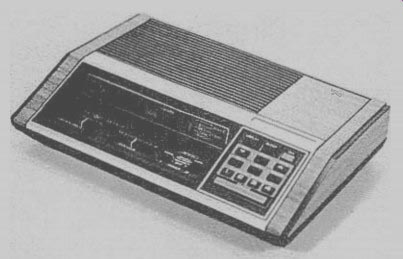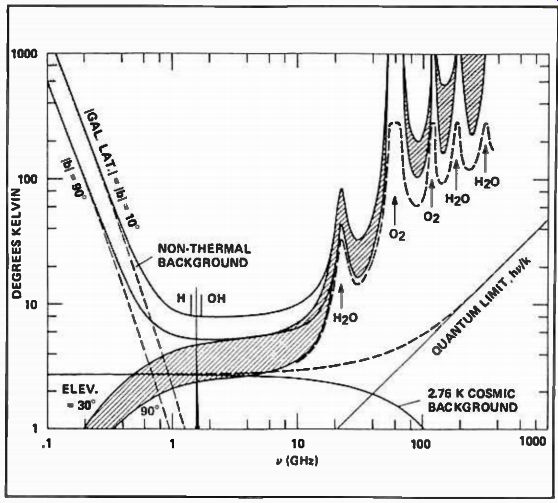This guide spans about 80 years of radio receiver technology. While this is a relatively short period, the advent of communications receivers has had its technological impact. One may ask: Where are we today? While the superheterodyne is still the most popular approach, with an i-f as high in frequency as 2 GHz, the trend is toward even higher i-f s. While selectivity is still achieved at lower frequencies such as 455 kHz. New technological discoveries in the consumer receiver market will definitely impact the commercial and military communications receiver.
The development of low cost microprocessor-controlled synthesizers, such as the one used in the GE 4870 clock radio shown in Fig. 1, will allow for more sophisticated communications receivers at lower costs in the near future.
Large-scale integrated circuits (LSI) are being developed to replace discrete functions not only in the i-f area but also in the front end and mixer areas. Extremely low-noise amplifiers using GaAs FET technology have been recently introduced, allowing receivers for the first time to listen deeper into space for possible signs of extraterrestrial life. In today's technology, such a specialized communications receiver can provide useful reception of intelligent signals from a planet located some 15,000 light years away.
Although this may seem as a great distance, it is only half way to the center of the Milky Way galaxy. It has been established that such a receiver will cover a preferred frequency range between 1400 MHz and 1727 MHz, the "water hole"* frequency.
'Oliver. B.M.. and Billingliam. J.: Project Cyclops, a design study of a system for detecting extraterrestrial intelligent life. NASA CR 114445, 1972.

Fig. 1. Technologies developed for the consumer market should provide
new, low cost solutions for the communications receiver of tomorrow.
The GE 4870 clock radio is one of the first microprocessor-controlled,
synthesized consumer radio, allowing for precise tuning of the AM and
FM bands. Four programmable memories are also provided for instant recall
at predetermined times, along with a variety of other microprocessor-controlled
functions.

Fig. 2. The "Water Hole" window provides the best overall
noise performance for an interstellar communications receiver. This frequency
band was also chosen as a meeting point for extraterrestrial civilizations
which base their existence on water. The signal shown represents the
hypothetical strength of a transmitter similar to that of the Arecibo
Observatory, located some 60 light years away and aimed at us.

Fig. 3. Aerial view of the world's largest Radio Observatory, Arecibo
in Puerto Rico where Extraterrestrial Intelligence (ETI) searches ,are
being conducted.
The Arecibo Observatory is part of the National Astronomy and Ionosphere Center which is operated by Cornell University under contract with the National Science Foundation.
The rationale behind this choice is based on the ideas that:
• Life in the Universe is a function of water.
• An extraterrestrial civilization attempting to communicate with us would transmit in the water frequency band which is located between the spectral line of hydrogen (1420 MHz) and the spectral lines of hydroxyl (1612 to 1727 MHz). Although other frequencies have been previously suggested, it has been recently discovered that this band of frequencies is the quietest in the spectrum as shown in Fig. 2.
Existing radio observatories such as the one shown in Fig. 3 are already searching the universe at the mentioned frequencies. An organized effort has been initiated in both the United States and the Soviet Union to systematically listen for extraterrestrial signals*. It is understood that the Soviet Receiving System will be dedicated for listening to wide-band omni-directional pulses. Several receivers located geographically apart will be looking for time of arrival coincidence of the pulses in order to identify their extraterrestrial nature. In the United States, the approach involves narrow-band signal processing with the help of highly directive antenna beams. While this method provides a superior signal-to-noise ratio, the probability of intercept is greatly reduced due to the relatively narrow antenna beamwidth and the narrow-band processing.
In order to increase the probability of intercept, new concepts in signal processing have evolved. Recent developments in cryogenically cooled up-converters with an i-f at 20 to 30 GHz and using Masers** as first i-f amplifiers, will provide exceptionally low noise and instantaneous bandwidths covering the "water hole" frequency range. Instantaneous detection was also achieved recently when, for the first time, interaction of light and sound has been implemented in the Bragg Cell Receiver.
**Microwave Amplification by Stimulated Emission of Radiation. Device similar to a laser which amplifies coherently generated microwave emissions.